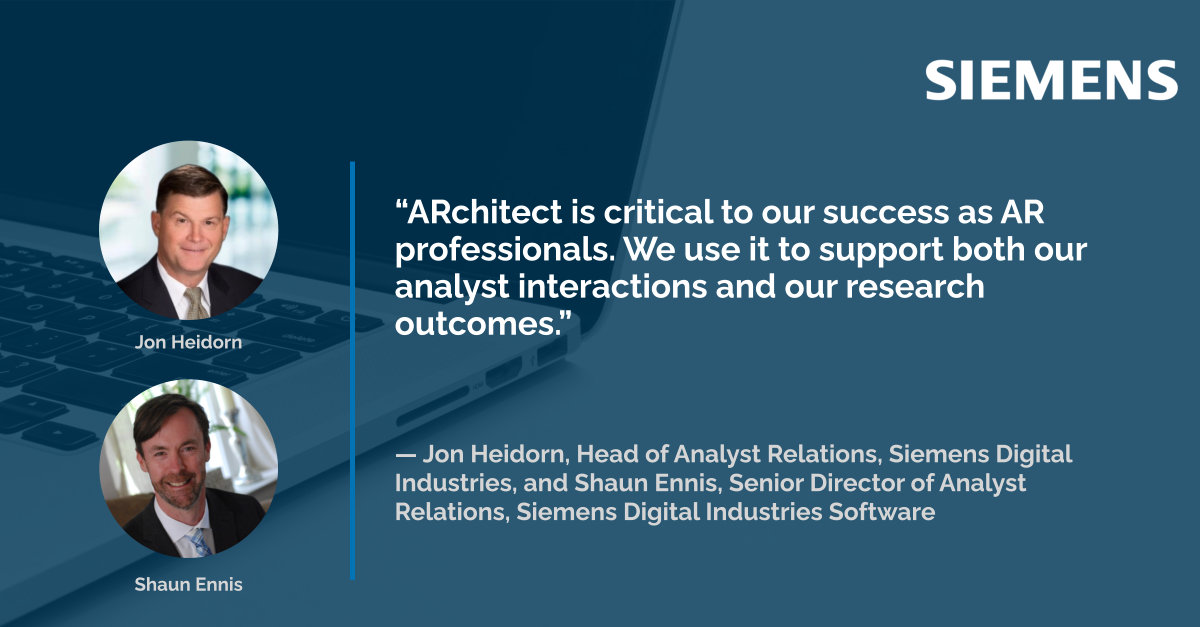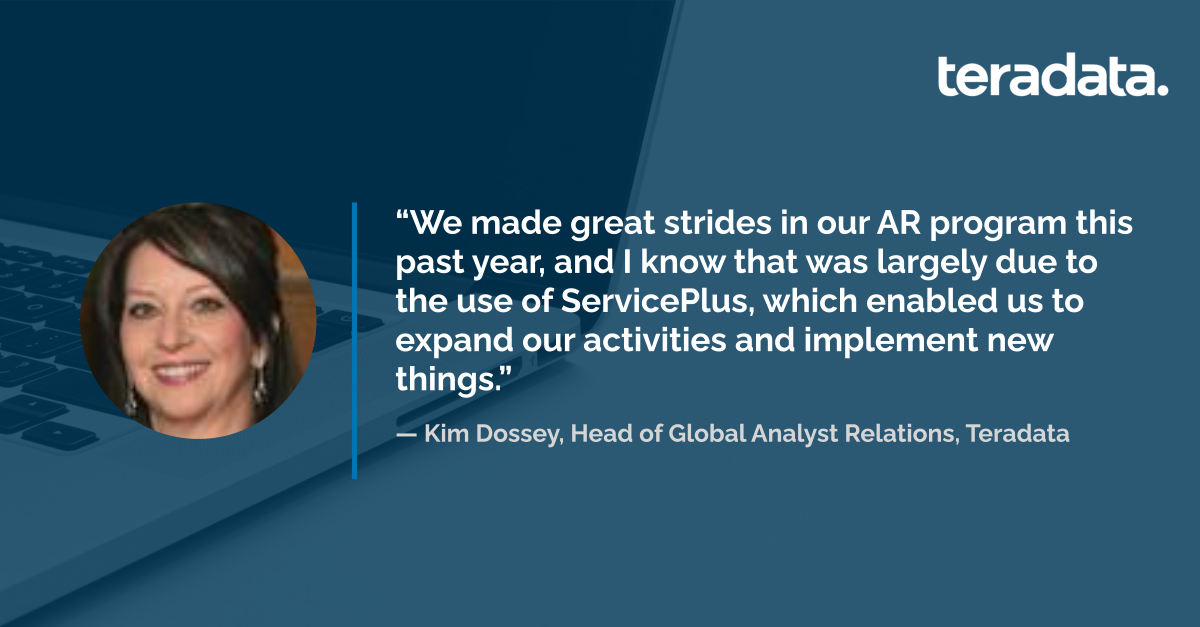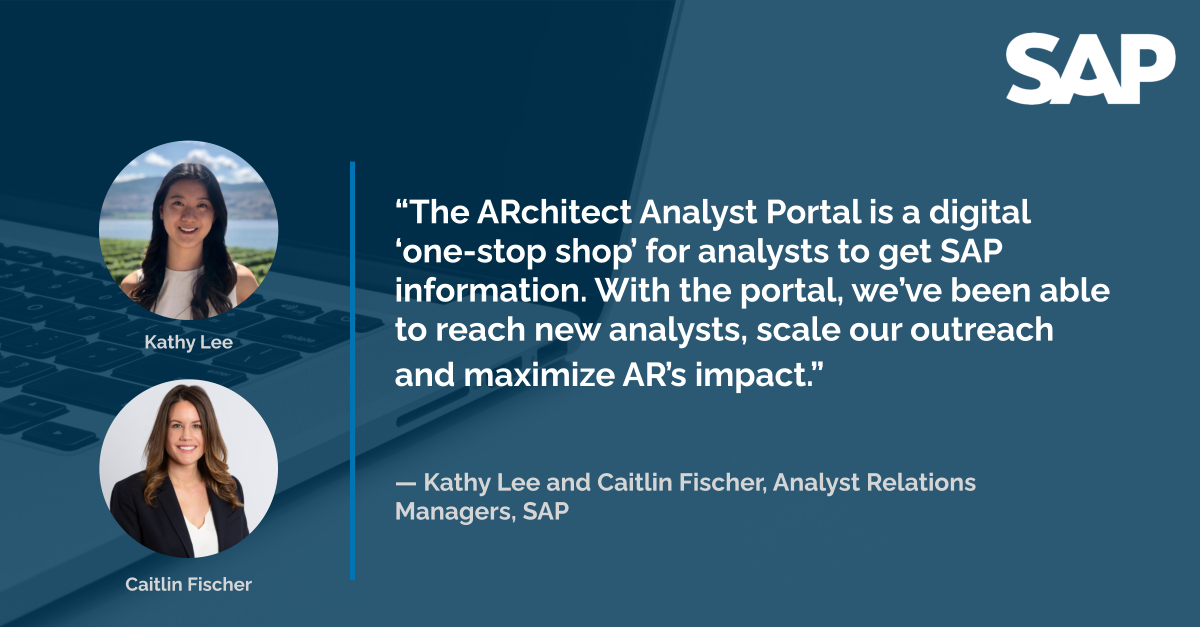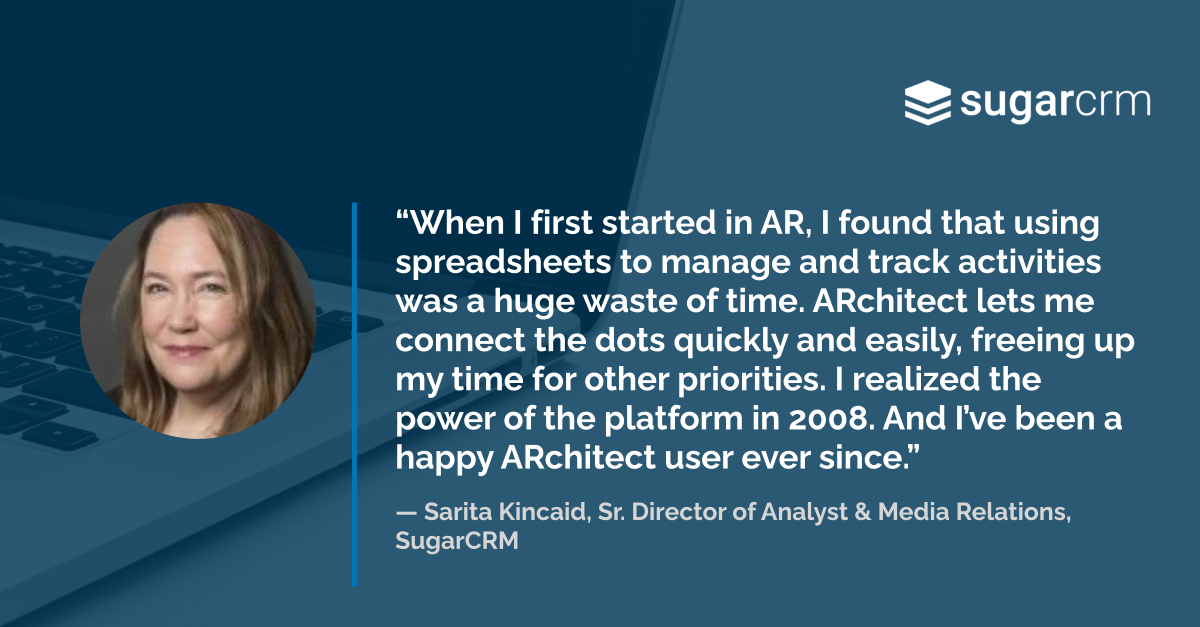Background
Siemens Digital Industries is an operating company of Siemens AG and a leader in industrial automation, software and services — helping companies digitally design and simulate products before they’re actually manufactured.
The Siemens Digital Industries analyst relations (AR) team is composed of five full-time professionals, aided by an “extended team” of subject matter experts (who assist with briefings, product questionnaires, etc.) and an AR council — with several liaisons from across the business, who provide ideas and opportunities for analyst engagement.
Each day, the core AR team seeks to keep industry analysts well-informed about Siemens Digital Industries and its many offerings, while gleaning insights from analysts as well.
Their strategic efforts and interactions bear fruit: Last year alone, Siemens Digital Industries was positioned as a leader in eight of the nine vendor evaluations it participated in, including “The Forrester Wave™: Product Lifecycle Management for Discrete Manufacturers, Q1, 2021, ” the “2021 Gartner Magic Quadrant for Manufacturing Execution Systems” and more!
Challenge
Thrilled by the top placements, the AR team (and business at large) wanted to identify and codify best practices during the evaluation process that had contributed to their positioning — to help replicate success in the future. They wanted to concentrate, specifically, on best practices related to analyst engagement.
They also sought to get a clearer view of all analyst interactions and activity, across their many campaigns (not just stack-ranking reports). Take it from Jon Heidorn, head of analyst relations at Siemens Digital Industries, and Shaun Ennis, senior director of analyst relations at Siemens Digital Industries Software: Their business communicates with a lot of analysts!
“We’re easily talking to 30 to 40 Tier 1 analysts, alone, across each one of the different segments we serve: supply chain, application development, deep engineering technology, operational technology and so on,” Shaun says. “That’s a pretty large and diverse group we have to influence and be influenced by.”
That means, at any given moment, and across a multitude of business segments, the AR team is managing Magic Quadrants, Waves and other evaluations; prepping executives for analyst calls; booking and staffing briefings; getting analyst feedback and insights; responding to inbound requests; sharing research coverage; and a lot (lot!) more.
With so many moving pieces, the AR team sought a solution that would provide central visibility into all activities and make it easy to report on results. And with hundreds of analysts to service, the AR team hoped to streamline its communications as well.
Solution
Siemens Digital Industries turned to ARInsights and its AR productivity software ARchitect. As ARchitect users for nearly 15 years, the Siemens team continually takes advantage of new functionality to meet its evolving needs.
Siemens Digital Industries uses ARchitect to:
- Manage AR activities and projects. “We’ve got a variety of topics, campaigns and reports we’re working on,” Shaun says, “and a lot of people involved. We needed something where we could log, manage and centralize our activities, and Excel obviously wasn’t going to get the job done. Managing activities in ARchitect keeps us aligned and provides visibility into how we can leverage the work other team members are doing.”
- Research relevant analysts, using ARchitect’s database of 8,000+ analysts and influencers.
- Search analyst research calendars to plan engagement strategies for upcoming, relevant reports.
- Track analyst coverage of Siemens Digital Industries and competitors, across reports, blogs, quotes in the media and tweets.
- Monitor the competitive landscape, using Premium Content to keep abreast of market trends.
- Create a self-service portal for analysts. Using the ARchitect Analyst Portal, Siemens Digital Industries provides analysts with a secure, digital destination where they can access Siemens product information, briefing decks, demos and more.
- Easily report on results, including analyst briefings and engagement, portal activity, share of voice and more.
And as for identifying those Magic Quadrant and Wave engagement best practices – Jon and Shaun use ARchitect for that too. They classify vendor evaluation reports as “projects” in ARchitect, track associated data and milestones, and use ARchitect to report on the information and patterns.
“We look at areas like: Who talked to the analysts; were execs involved? How much time did our company spend with the analysts? What types of interactions (briefing or inquiry) were used? What was the tone of the conversations?” Shaun says. “As we looked across the reports where we’d had great successes, we wanted to forensically analyze what made us perform so well.”
Jon sums it up: “ARchitect helps us track all our interactions, and correlate interactions with outcomes.”
Results
In the eight evaluations where Siemens Digital Industries was positioned as a leader, the AR team saw patterns in the type, composition and duration of interactions.
“For example,” Shaun says, “we found that if you can involve a major executive, and have them participate from the get-go, that leads to better outcomes. Also, as many AR pros probably know, the Magic Quadrant doesn’t start when you get the welcome packet. It probably starts in earnest when the previous MQ ends — so it’s important to keep up a dialogue with the analysts. For us, before the evaluation officially begins, during the process, post-mortem and at all points in between, there’s no doubt that ARchitect helps us drive successful interactions. We can manage them now, and we know how to make sure the right mix of things are happening from an interaction point of view.”
Jon notes: “Highlighting these connections is also important as we work with our extended AR team of subject matter experts and business liaisons, who may not be AR pros day in and day out. By finding and establishing best practices, and understanding how we use ARchitect to help drive them, we get a higher level of output. And, at any given time, we have a more holistic view of where we’re at in a project, what other elements need to get done and if we need to course-correct.”
Shaun says the AR team recognizes, of course, that optimal analyst interactions aren’t the only component of successful vendor evaluations — you also need to have solid responses to the questionnaire, an impressive demo and glowing customer references (or Peer Insights reviews), among other areas.
“These items are very important too,” he says. “But as it relates to interactions, we’re thankful that we now have a playbook on how to make sure our internal forces are marshaled — and on how we can use ARchitect to help us drive interactions that, we think, will forecast a successful outcome.”
Apart from establishing evaluation best practices, Siemens Digital Industries has seen other benefits from its use of ARchitect:
- Identifying new, relevant analysts who support Siemens’ business goals.
- Reaching more analysts and reducing email “back-and-forth,” through the Analyst Portal. The portal enables Siemens Digital Industries to provide information to analysts it might not have had time to reach previously (such as at smaller and niche firms) and cuts down on emails the team needs to send. “We thought the portal would just be for our Tier 2 analysts, but a lot of the Tier 1s go on too and self-serve,” Jon says. “They can get information they need without having to email us and ask.”
- Generating more interest in, and visibility for, AR. “An offshoot of all our success,” notes Shaun, “is that even in the last couple months, there’s been much greater interest from folks internally in our AR program and in listening to what analysts have to say. More people are seeing the value of analyst research, as well as analyst advice. So, as a company, we’re not just communicating, one-way, to analysts, but we’re also ingesting what they’re saying and getting that virtuous cycle of communications going.”




